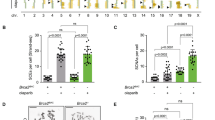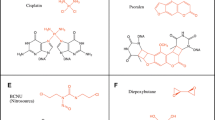Summary
Twin and single sister chromatid exchanges (SCEs) induced by short treatments with mitomycin C (MC) and 4,5′,8-trimethylpsoralen (TMP)-plus-near ultraviolet light (NUV) were analyzed in colcemid-induced endoreduplicated normal human and typical Fanconi's anemia (FA) fibroblasts with diplochromosomes. The induction rate of twin SCEs that had occurred in the first cycle (S1) after the treatment was 1.7–2.4 times higher in FA cells than in normal cells. The induction rate of single SCEs that had arisen during the second cycle (S2) long after the treatment was also much higher, though less than the twin SCE rate, in FA cells than the almost neglible rate after repair of cross-links and monoadducts in normal cells. These results in FA cells, which specifically lack the first half-excision step of the two-step cross-link repair but retain the normal monoadduct repair, indicate that MC or TMP cross-links remaining unrepaired are indeed responsible for higher inductions of twin (S1 exchange) and single SCEs (S2 exchange). Thus, these findings indicate that Shafer's model of replication bypass for cross-link-induced SCE, which predicts greatly reduced twin SCE formation in FA cells due to half cancellation, is apparently inadequate as such. We present three plausible models, incorporating the ordinary replication model, random unilateral cross-link transfer, and chromatid breakage/reunion, that can account for the probabilistic inductions of single and twin SCEs and even for no SCE formation.
Similar content being viewed by others
References
Carrano AV, Thompson LH, Stekta DG, Minkler JL, Mazrimas JA, Fong S (1979) DNA crosslinking, sister-chromatid exchanges and specific locus mutations. Mutat Res 63:175–183
Cole RS (1971) Psoralen monoadducts and interstrand cross-links in DNA. Biochim Biophys Acta 254:30–39
Fujiwara Y (1982) Measurement of mitomycin C crosslinks in DNA of human cells. In: Friedberg EC, Hanawalt PC (eds) DNA repair—A laboratory manual of research procedures, part B. Marcel Dekker, New York (in press)
Fujiwara Y, Kano Y, Tatsumi M, Paul P (1980) Effects of a tumor promoter and an antipromoter on spontaneous and UV-induced 6-thioguanine-resistant mutations and sister chromatid exchanges in V79 Chinese hamster cells. Mutat Res 71:243–251
Fujiwara Y, Tasumi M (1975) Repair of mitomycin C damage to DNA in mammalian cells and its impairment in Fanconi's anemia cells. Biochem Biophys Res Commun 66:592–598
Fujiwara Y, Tatsumi M, Sasaki MS (1977) Crosslink repair in human cells and its possible defect in Fanconi's anemia cells. J Mol Biol 113:635–649
Ishii Y, Bender MA (1980) Effects of inhibitors of DNA synthesis on spontaneous and UV-induced sister-chromatid exchanges in Chinese hamster cells. Mutat Res 79:19–32
Iyer VM, Szybalski W (1964) Mitomycins and profiromycin: chemical mechanism of activation and crosslinking of DNA. Science 145:55–58
Kano Y, Fujiwara Y (1981) Roles of DNA interstrand crosslinking and its repair in the induction of sister-chromatid exchanges and a higher induction in Fanconi's anemia cells. Mutat Res 81:365–375
Kato H (1977) Spontaneous and induced sister chromatid exchanges as revealed by the BUdR labelling method. Int J Cytol 49:55–97
Kato H, Shimada H (1975) Sister-chromatid exchanges induced by mitomycin C: a new method of detecting DNA damage at chromosomal level. Mutat Res 28:459–464
Latt SA (1974) Sister chromatid exchanges, indices of human chromosome damage and repair: detection by fluorescence and induction by mitomycin C. Proc Natl Acad Sci USA 71:3162–3166
Latt SA, Stetten E, Jeurgens LA, Buchanan AR, Gerald PS (1975) Induction by crosslinking agents of sister chromatid exchanges and chromatid breaks in Fanconi's anemia. Proc Natl Acad Sci USA 72:4066–4070
Painter RB (1980) A replicative model for sister chromatid exchange. Mutat Res 70:337–341
Perry P, Evans HJ (1975) Cytological detection of mutagen-carcinogen exposure by sister chromatid exchanges. Nature 258:121–125
Reid BD, Walker IG (1969) The response of mammalian cells to alkylating agent. II. On the mechanism of the removal of sulfurmustard-induced crosslinks. Biochim Biophys Acta 179:179–188
Sasaki MS (1977) Sister chromatid exchange and chromatid interchange as possible manifestation of different repair processes. Nature 269:623–625
Sasaki MS (1979) Chromosome aberration formation and sisterchromatid exchanges in relation to DNA repair in human cells. In: Generoso WM, Shelby MD, DeSeeres FJ (eds) DNA repair and mutagenesis in eukaryotes. Plenum, New York, pp 285–313
Sasaki MS, Tonomura A (1973) A high susceptibility of Fanconi's anemia to chromosome breakage by DNA crosslinking agents. Cancer Res 33:1829–1836
Shafer DA (1977) Replicative bypass model of sister chromatid exchanges and implications for Bloom's syndrome and Fanconi's anemia. Hum Genet 39:177–190
Stekta DG (1979) Further analysis of the replication bypass model for sister chromatid exchange. Hum Genet 49:63–69
Wolff S (1978) Relation between DNA repair, chromosome aberrations, and sister chromatid exchanges. In: Hanawalt PC, Friedberg EC, Fox CF (eds) DNA repair mechanisms. Academic Press, New York, pp 751–760
Wolff S, Perry P (1975) Insights on chromosome structure from sister chromatid exchange ratios and the lack of both isolabelling and heterolabelling as determined by the FPG technique. Exp Cell Res 94:23–30
Wolff S, Rodin B, Cleaver JE (1977) Sister chromatid exchanges induced by mutagenic carcinogens in normal and xeroderma pigmentosum cells. Nature 265:347–349
Author information
Authors and Affiliations
Additional information
This work was supported in part by a grant-in-aid for cancer research from the Ministry of Education, Science and Culture, Japan
Rights and permissions
About this article
Cite this article
Kano, Y., Fujiwara, Y. Higher inductions of twin and single sister chromatid exchanges by cross-linking agents in Fanconi's anemia cells. Hum Genet 60, 233–238 (1982). https://doi.org/10.1007/BF00303010
Received:
Issue Date:
DOI: https://doi.org/10.1007/BF00303010




